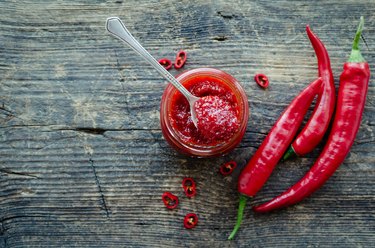
Powdered cayenne pepper vs chili powder may look similar, but they taste very different. While both of these spices contain capsaicin, the substance in hot peppers that makes your mouth burn, cayenne pepper usually packs a bigger punch.
It also lacks the extra ingredients that you'll find in most blended chili powder preparations. You can substitute one for the other in some recipes, but you might need to adjust your other ingredients to account for the change in flavor.
Video of the Day
Video of the Day
According to the National Heart, Lung, and Blood Institute, both cayenne pepper and chili powder can be used to season food if you're watching your sodium intake. Healthy adults should consume no more than 2,300 milligrams of sodium per day, according to the American Heart Association.
Read more: Calories for a Bowl of Chili
Check the Heat
Food scientists classify cayenne as a medium-hot variety of pepper. According to Colorado State University Extension, this spice clocks in at between 30,000 and 50,000 units on the Scoville scale, a method of measuring the amount of capsaicin in a hot pepper.
New Mexico University points out that the Scoville scale is a subjective spiciness scale and some people can be more sensitive to capsaicin than others.
Chili powders come in at between 500 and 1,500 Scoville units. That's enough to produce a mild burn, but not enough to make really spicy foods.
Consider a Blend
As its name implies, chili powder works well for making meaty, bean chili. This convenience mix includes ground chili peppers and spices like cumin, garlic powder, oregano and salt. You can add it to your chili or other recipes without worrying about how to balance the spices.
This mix also allows you to keep just one jar on hand. If you use it in recipes that call for cayenne pepper, however, it could add extra flavors you weren't counting on.
While most "chili powder" sold in US grocery stores contains blended spices, this term can also be used for powdered hot peppers on their own. This usage is common in Asian recipes and grocery stores. These powders tend to be much spicier than blended American chili powder.
If you are using a recipe that calls for powdered chili peppers of this kind, you can usually use cayenne pepper substitute without significantly changing the taste of the dish.
Make Your Own
Sometimes the spices you need aren't readily available. Whether you don't have access to a store that carries the right selection or you've run out temporarily, there are substitutions available for both chili powder and cayenne pepper.
If you are making an American recipe that calls for blended chili powder, but you need a chili powder substitute, make your own by combining two parts ground hot pepper with one part ground cumin and one part ground oregano.
If you don't have cayenne pepper, try using hot paprika or red pepper flakes as a cayenne pepper substitute instead.
- Colorado State University Extension: "Keeping Food Safe: Chile Peppers"
- National Heart, Lung, and Blood Institute: "Use Herbs and Spices Instead of Salt"
- American Heart Association: "How Much Sodium Should I Eat Per Day?"
- New Mexico State University: "Measuring Chile Pepper Heat"
- The Kitchn: Chili Powder